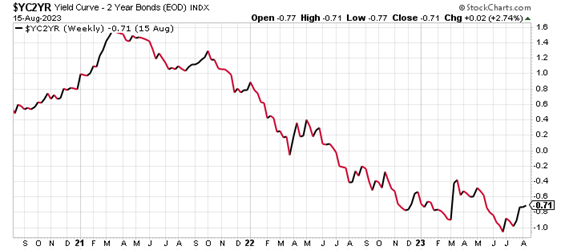Why Odds of Financial Crisis Are Higher Than Before
Not too long ago, President Joe Biden called the economic situation in China a “ticking time bomb.” Certainly, the conditions in the second-biggest economy in the world are worsening and could get a lot worse, but there’s another ticking time bomb that shouldn’t be ignored: a financial crisis in the U.S. could happen in no time.
It’s important to look at what’s been happening with derivatives.
Warren Buffett has called derivatives weapons of mass financial destruction, which is very true; they can amplify problems. The last financial crisis, in 2008–2009, was a result of derivatives getting out of hand and leading to massive problems in the financial system.
Could something similar happen again?
There’s a colossal amount of derivatives out there these days. For instance, U.S. banks held derivatives with a notional value of $217.6 trillion in the first quarter of 2023. This amount increased by $26.6 trillion, or close to 14%, from the fourth quarter of 2022. (Source: “Quarterly Report on Bank Trading and Derivatives Activities: First Quarter 2023,” Office of the Comptroller of the Currency, last accessed August 16, 2023.)
Here’s something more troubling: the vast majority of the derivatives (73.6%, or $160.3 trillion worth) in the U.S. financial system are concentrated in interest-rate products.
Even if a small number of derivatives go bad, it’s possible there will be mass hysteria, bank collapses, and a financial crisis.
See a problem?
What Happens to Derivatives as Interest Rates Get Volatile?
There’s a lot of uncertainty around interest rates at the moment. One camp is saying the Federal Reserve will pause its interest rate hikes, while the other camp is saying we need more rate hikes.
But don’t get fixated on just the Fed; take a look at what’s been happening in the bond market.
See the chart below. It plots the difference between the yields on two-year U.S. treasury bonds and the yields on 10-year U.S. treasury bonds. Economists refer to this difference as the yield curve.

Chart courtesy of StockCharts.com
As it stands, the yield curve is tormented—it’s inverted. This means the yields on long-term U.S. bonds are lower than the yields on short-term bonds. Eventually, the yield curve will normalize, meaning yields on long-term bonds will be higher than the yields on short-term bonds. This always happens.
When the yield curve starts to normalize, it will have an impact on interest rates. You have to wonder what will happen to all the derivatives that are out there.
Think global as well. Central banks around the world have been raising interest rates or questioning how high they should go.
Moreover, many countries’ economies are facing headwinds. The eurozone is teetering on the edge of a recession, Japan’s central bank is trying to control the yields on its government bonds, Britain’s central bank keeps raising its interest rates, and the list goes on.
All in all, there’s a lot of uncertainty and volatility around interest rates.
Investors Beware: Complacency Could End Badly
Dear reader, I saw the financial crisis of 2008–2009. It was very interesting, to say the least.
At the beginning of that period, we were told that everything was under control and that there wasn’t really any need to panic. Eventually, however, it became clear that nothing was under control. Investors panicked, the financial world went through severe volatility, the economy suffered, and scores of banks—including Lehman Brothers and Bear Stearns—went under.
I can’t stress this enough: the sheer amount of derivatives in the U.S. financial system right now is a ticking time bomb that shouldn’t be ignored, especially while interest rates are volatile.
For a derivative transaction to take place, you need two parties. Let’s assume that a large number of the current derivatives are well hedged, and that those who are behind these derivatives are in good financial shape and will pay up when the time comes.
But what if a small percentage of these derivatives go bad? That could do an immense amount of damage to the financial sector.
Furthermore, don’t forget the contagion factor. So far, there’ve been a few bank failures in the U.S. Some have regarded this as a non-issue, but don’t be too complacent. We aren’t through it all, and the odds of a financial crisis are now higher than they were a year ago.
Lastly, during a financial crisis, liquidity in the broad market dries up. If market participants even get a whiff of something bad happening, there could be mass selling across the board. Investors should keep track of what they own and not let their losses get too big if that situation arrives.






